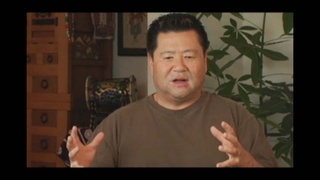Interviews
Soukou Bayashi: Dedicated to the Issei (Japanese)
(Japanese) Well, it’s no big deal. When I started to hit on the taiko even though I am a lousy drummer, the older Issei men and women really loved it and some were even moved to tears. It made me feel so good when I discovered that beating the taiko over here in America could bring so much joy to the Isseis. I gradually began to delve into the Japanese American history and learn about the Issei. I felt I ought to play better for the folks who had come over here in the Meiji era (1868 ~ 1912) and endured hardship. Well, that’s how it started.
So, I composed a dance song in the early 70’s and named it Soukou Bayashi -- Soukou is the other name for San Francisco.1 This music is dedicated to the Issei. Without their hard work, guys like us you know, Fresh off the Boats, would not be able to be here today. Well, that’s what I found out over the years and so Soukou Bayashi is my first song and it is dedicated to the first generation.
Note:
1. Based on the Japanese phonetic reading of kanji that the Chinese have assigned to San Francisco. Hayashi is the percussive element in traditional Japanese music to keep cadence.
Date: January 27, 2005
Location: California, US
Interviewer: Art Hansen, Sojin Kim
Contributed by: Watase Media Arts Center, Japanese American National Museum.
Explore More Videos

Changing the taiko rhythm from Japanese to Afro-Cuban
Senshin Buddhist Temple minister and co-founder of Kinnara Taiko.

Friction between Sensei and Kinnara in defining taiko
Senshin Buddhist Temple minister and co-founder of Kinnara Taiko.

Collaborating with non-taiko groups
(b.1952) Master drummer, artistic director of the Taiko Center of the Pacific

American influences on Japanese taiko
Senshin Buddhist Temple minister and co-founder of Kinnara Taiko.


Taiko is a reflection of where you live
Senshin Buddhist Temple minister and co-founder of Kinnara Taiko.

Playing traditional gagaku while creating an identity
Senshin Buddhist Temple minister and co-founder of Kinnara Taiko.

Taiko as self-expression
Co-founder and creative director of San Jose Taiko

A “principally-based” taiko group in England creating a global taiko community
Co-founder and creative director of San Jose Taiko

Defining a Taiko player
(b.1951) Co-founder and managing director of San Jose Taiko.

Decision between becoming a minister or musician
(b. 1949) Musician and arts educator and adminstrator.

Japanese American taiko is not Japanese taiko
(b. 1949) Musician and arts educator and adminstrator.

Parents didn't accept me playing taiko in the beginning
(b. 1949) Musician and arts educator and adminstrator.

Tango makes him to stay in Argentina (Spanish)
(1925-2014) La Plata Hochi, Journalist

